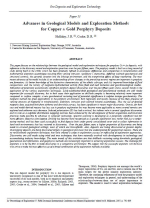Добрый день, Коллеги. Важное сообщение, просьба принять участие. Музей Ферсмана ищет помощь для реставрационных работ в помещении. Подробности по ссылке
Advances in geological models and exploration methods for copper ± gold porphyry deposits / Достижения в области геологических моделей и методов разведки медно- золотопорфировых месторождений
This paper focuses on the relationships between the geological model and exploration techniques for porphyry Cu ± Au deposits, with reference to the discovery record and exploration practices over the past fifteen years. The porphyry model is built on a long record of study dating back to the 1960s which has been gradually refined to encompass differences and complexities in mineralization and hydrothermal alteration assemblages resulting from varying intrusion (‘porphyry’) chemistries, differing wallrock geochemical and structural controls, the upwards zonation into the lithocap environment, and the overprinting effects of deep weathering. The most recent advances of the model include:(i) an understanding of how changes to the prevailing tectonic regime are important in porphyry ore formation; (ii) better knowledge of the distinctive characteristics of the alkalic sub-type, and (iii) improved knowledge of fluid compositions and the history of magmatic-hydrothermal activity from fluid and melt inclusion and geochronological studies. Tabulation of potentially economically significant porphyry deposit discoveries over the past fifteen years shows secular trends in the application of the various exploration techniques. Long-established field geological and geochemical methods are still vitally important for successful discovery, but in both cases their application on drillhole samples is becoming relatively more important compared to surface samples. A new geochemical vectoring tool of potential significance is sulphur isotope geochemistry. The magnetic method has great applicability in the porphyry environment, both regionally and locally, because of the likely presence of varying amounts of magnetite in mineralization, alteration, intrusion and wallrock mineral assemblages. Thus the use of detailed magnetic data, acquired both from airborne and downhole surveys, has been significant in recent major discoveries. Gravity, for both cost and model-derived reasons has less use in porphyry exploration but may become more applicable as more covered terrains are explored and airborne costs decrease. Induced polarization (IP) has had a critical, but indirect role in several significant discoveries and its role as a sulphide distribution mapping tool has been enhanced by the development of better acquisition and inversion practices made possible by advances in computer technology. Spectral scanning is developing as a potentially significant tool for more efficient, objective core-logging. Drilling has become more recognised as a specific exploration tool, rather than just a target-testing method, and has been used successfully to find deposits both under poorly consolidated cover and to collect information in hard rock environments that has vectored to discoveries. Over the past fifteen years a higher proportion of discoveries are being made in covered geological settings, most of which are brownfields. Also, deposits are being discovered at greater depths. Outcropping deposits are being discovered largely in geological provinces that are underexplored for geopolitical reasons. There are no revolutionary exploration techniques that have created a surge in exploration success or refocusing of exploration approaches. Discoveries are still made using tried and true techniques that have naturally evolved with developments in technology and accumulating industry knowledge. The main trends of this evolution are that drillhole vectoring using downhole geological, geochemical and information, and geophysics methods are increasingly important in achieving exploration success. The challenge for explorers is to be the first to make discoveries in a competitive environment. We suggest that the successful explorers will be those who strive to make the most effective use of a broad combination of the exploration methods available.




